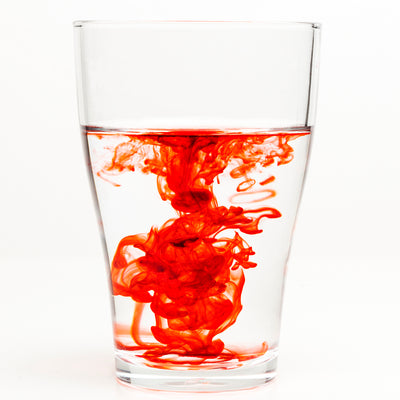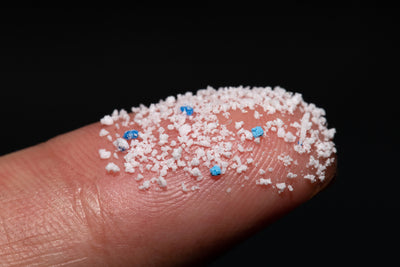Water Quality InformationWritten By Actual Experts
RSSWhat’s the Slimy Pink Stuff in My Bathroom?

Here’s Why You Shouldn’t Drink or Cook With Water From the Hot Water Side of Your Faucet:

What Does The Red Dye Test Actually Measure?

Eric Roy, PhD & Analies Dyjak, M.A.
The Red Dye Test is a visual demonstration used in marketing materials by various water filtration companies. In this demonstration, red food coloring is added to water and passed through a filter, where it comes out clear. Oftentimes this demonstration is done in a “side by side” manner against another water filter that does not remove the red coloring from the water. This demonstration suggests to the consumer that:-
If a water filter can remove red dye, it’s also removing dangerous contaminants. In scientific terms, they’re suggesting that red dye is a “proxy” or “surrogate” for dangerous contaminants.
-
Water filters that do not remove the red color are not as effective as water filters that do remove red food coloring.
Is Red Food Coloring a Representative Proxy or Surrogate for Contaminants in Drinking Water?
Absolutely not. Identifying a representative proxy/surrogate requires that a credible testing body (e.g NSF/ANSI) has actually done experiments to validate it. An example of a representative surrogate test is NSF/ANSI Standard 53 for VOCs, where the certifying bodies have shown (through testing) that chloroform is an effective surrogate for roughly 50 VOCs. No such testing has been done (or to our knowledge attempted) for red food coloring. It goes without saying, if the visual removal of red food coloring was a representative surrogate for water filter performance, credible water filter companies would not be spending millions of dollars on research, development, testing, and evaluation.
Are Water Filters That Do Not Remove Red Food Coloring Less Effective At Removing Dangerous Chemicals?
Absolutely not. For example, one of the brands that prominently markets using the red dye test was part of a water filter evaluation study conducted by Duke and NC State University, and failed miserably. Conversely, various products that do not remove red food coloring (Hydroviv’s included) were effective in filtering “hard-to-filter” PFAS from the challenge solutions. So while the brand effectively removes food-safe red dye, it isn’t able to remove PFAS. In fact, higher levels of PFAS were detected in the filtered water because the filtration media was likely oversaturated. In short, red dye is extremely easy to remove and is not an actual indication of filter performance or contaminant removal.
Is There a Quick and Easy Way To See if My Filter is Working?
While we wish there was an at-home test that could determine if your filter is doing its job, that unfortunately isn’t the case. Every home in America would test their water on a regular basis if at-home test kits provided actual information about water quality. If you want to test for contaminants, you’ll need to send a water sample to an accredited laboratory and test for a range of contaminants. This can cost thousands of dollars and doesn’t provide immediate results. The best way to ensure that you’re using an effective product is to buy products from companies that use third party testing & certifications.
Summary: The Red Dye Test is a Marketing Gimmick
The red dye test tells us almost nothing about filtration performance and shouldn’t be used as a proxy/surrogate for harmful contaminants.
Other Articles Recommended For You:Stop Using TDS/ppm Testers to Evaluate Water Quality
What Are Per and Polyfluoroalkyl Substances (PFAS)?
Why Some Water Filters Are More Effective Than Others
95% of U.S. Tap Water Contains Microplastics

Water Utility Shuts Down Wells Following 'Concerning Levels' of PFAS

Analies Dyjak, M.A. | Head of Policy and Perspectives
The city of Eau Claire, Wisconsin is in the national spotlight for PFAS contamination in drinking water. The city’s water utility provider shut down half of it's wells due to unsafe levels of PFAS earlier this month. PFAS are a category of harmful contaminants that are known to cause cancer and other dangerous health impacts.
Where Is The PFAS Pollution Coming From?
PFAS pollution has contaminated half of the 16 drinking water wells in the city of Eau Claire. The Wisconsin Department of Natural Resources (DNR) believes that the contamination originated from the Chippewa Valley Regional Airport in Eau Claire. Airports and military bases are known to be a main source of PFAS contamination due to the excessive use of firefighting foam during training activities. PFAS are a key ingredient in firefighting foam because of their ability to act as a surfactant and suppress fire. You might see PFAS referred to as Aqueous Fire Fighting Foam or AFFF in this particular context. Camp Lejeune, McClellan Air Force Base, Pease Air Force Base, and Gerald R. Ford International Airport are some of the more well known incidences of AFFF contamination. There are however several other sources of PFAS that could be contributing to the contamination, including nearby PFAS manufacturing and processing facilities.
How Is Eau Claire Mitigating The Problem?
One of the most difficult hurdles faced by municipalities across the country is what to do with the PFAS once its contaminated a water supply. The Utilities Manager for the City of Eau Claire stated that they’re currently emptying out their wells and dumping contaminated water into “absorption ponds.” These ponds are a temporary solution and are problematic in their own way. PFAS can still seep from the absorption ponds into surrounding soil and groundwater. The utilities manager said in a recent interview that the absorption ponds are located in an area that “should not impact municipal drinking water.” The absorption ponds also don’t take into consideration the health of aquatic species and other organisms in that habitat. PFAS are known to bioaccumulate in fish, which could indirectly affect humans throughout the food chain.
City officials made the decision not to provide bottled water to its residents, and continue to allow them to drink the contaminated water on the grounds that it’s “under the DNR hazard index level” of 20 parts per trillion. Proactive sampling occurred in 2020, which found that Eau Claire wells had detectable levels of PFAS. In 2021 when the hazard index was introduced in the state of Wisconsin, the utility department determined that PFAS were then problematic.
What’s Next For The City of Eau Claire?
There are currently no mitigation plans and several unknowns regarding the next steps for the city of Eau Claire. State and local officials are still unsure of the size of the plume, the direction of the plume, and the levels that they are dealing with. The City of Eau Claire has hired an engineering firm to assist with answering some of these questions as well as a cost estimate for future action. The utilities manager did however say that since removing PFAS-contaminated water, PFAS levels had decreased in 5 of the city wells.
Once PFAS are in a water supply it’s nearly impossible to eliminate all of the contamination. Water treatment plants will simply focus on water that’s actually being consumed by members of a community, which includes purchasing proper filtration technologies. It’s important to note that Eau Claire is not the only municipality that has taken water sources “offline” due to PFAS contamination. The community of Bethany Crest, Delaware was told to only use bottled water for drinking and cooking due to “concerning levels” or PFAS. Many municipalities are testing for PFAS for the very first time, so there’s no way of knowing how long PFAS has been a problem in either of these communities.
Our Take:
The utilities manager in an interview with Wisconsin Public Radio stated that “the city of Eau Claire’s water is safe and always has been.” We’ve seen similar statements from public officials in other states when their water was in fact not safe at all. The mayor of Newark, NJ made a similar statement about lead levels that were almost two times higher than the federal limit, claiming that Newark’s water was not only safe, but “some of the best in New Jersey.” We suggest first taking a look at this Environmental Working Group (EWG) map to see if PFAS have been detected in your area. You may also consider purchasing a filter that removes PFAS contaminants.
Other Articles We Think You Would Enjoy:Water Filters That Remove PFAS Chemicals:
Does My State Regulate PFAS in Drinking Water?
Study: PFAS Detected in Popular Bottled Water Brands






